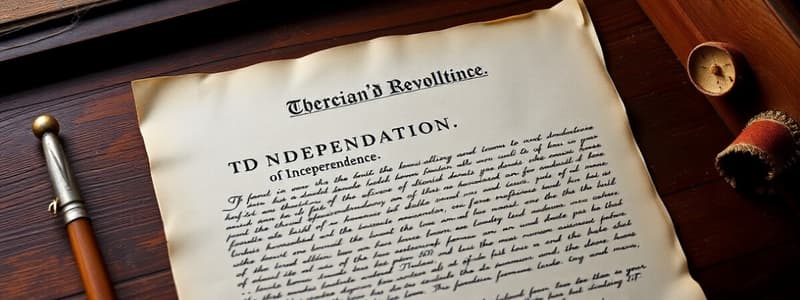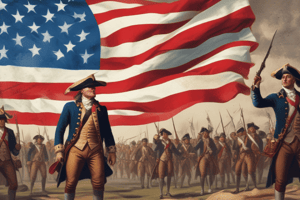Podcast
Questions and Answers
What key argument did Thomas Paine make in Common Sense that influenced colonists?
What key argument did Thomas Paine make in Common Sense that influenced colonists?
- The colonies should unite and declare independence from Britain. (correct)
- The economic benefits of remaining a British colony outweighed the disadvantages.
- The colonies should seek reconciliation with Britain through peaceful negotiations.
- The British monarchy was divinely ordained and should be respected.
Which statement accurately reflects Richard Henry Lee's contribution to the movement for independence?
Which statement accurately reflects Richard Henry Lee's contribution to the movement for independence?
- He drafted the Articles of Confederation, outlining a system of governance for the newly independent states.
- He advocated for maintaining ties with the British monarchy while seeking reforms.
- He led the British forces in key battles against the Continental Army.
- He proposed a resolution in Congress declaring the colonies' independence from Britain. (correct)
Why was Thomas Jefferson chosen to draft the Declaration of Independence?
Why was Thomas Jefferson chosen to draft the Declaration of Independence?
- He was the oldest and most experienced member of the Continental Congress.
- He was known for his eloquent writing style and legal expertise. (correct)
- He was a representative of Massachusetts, a key state in the independence movement.
- He was a close friend of King George III and could negotiate favorable terms.
What is the primary purpose of the preamble in the Declaration of Independence?
What is the primary purpose of the preamble in the Declaration of Independence?
Which of the following best describes the list of grievances in the Declaration of Independence?
Which of the following best describes the list of grievances in the Declaration of Independence?
What was the significance of the public reading of the Declaration of Independence on July 8, 1776?
What was the significance of the public reading of the Declaration of Independence on July 8, 1776?
John Hancock famously signed the Declaration of Independence in large script. Why?
John Hancock famously signed the Declaration of Independence in large script. Why?
Why was signing the Declaration of Independence considered a dangerous act?
Why was signing the Declaration of Independence considered a dangerous act?
Abigail Adams advocated for the Continental Congress to recognize rights for which group?
Abigail Adams advocated for the Continental Congress to recognize rights for which group?
What was the purpose of the Articles of Confederation?
What was the purpose of the Articles of Confederation?
Under the Articles of Confederation, how many votes did each state have in the national Congress?
Under the Articles of Confederation, how many votes did each state have in the national Congress?
What was a significant weakness of the Articles of Confederation regarding law enforcement?
What was a significant weakness of the Articles of Confederation regarding law enforcement?
Which power did the Congress NOT have under the Articles of Confederation?
Which power did the Congress NOT have under the Articles of Confederation?
Why did many Americans fear a strong national government under the Articles of Confederation?
Why did many Americans fear a strong national government under the Articles of Confederation?
What was the requirement for passing a law in the Congress under the Articles of Confederation?
What was the requirement for passing a law in the Congress under the Articles of Confederation?
Flashcards
Common Sense
Common Sense
A pamphlet written by Thomas Paine that advocated for the colonies to break free from British rule and form their own country.
Declaration of Independence
Declaration of Independence
A formal statement written to King George III declaring the colonies' freedom and reasons for separation.
Thomas Jefferson
Thomas Jefferson
He was a lawyer from Virginia, who wrote the first draft of the Declaration of Independence.
Preamble
Preamble
Signup and view all the flashcards
Unalienable Rights
Unalienable Rights
Signup and view all the flashcards
Grievances
Grievances
Signup and view all the flashcards
July 4, 1776
July 4, 1776
Signup and view all the flashcards
John Hancock
John Hancock
Signup and view all the flashcards
Treason
Treason
Signup and view all the flashcards
Articles of Confederation
Articles of Confederation
Signup and view all the flashcards
Confederation Congress
Confederation Congress
Signup and view all the flashcards
Lack of Enforcement Power
Lack of Enforcement Power
Signup and view all the flashcards
State Power
State Power
Signup and view all the flashcards
Limited Financial Power
Limited Financial Power
Signup and view all the flashcards
Study Notes
- Thomas Paine wrote "Common Sense" to persuade colonists to seek independence from Britain.
- Colonists began advocating for independence or freedom from British rule.
- John Adams, a delegate from Massachusetts, strongly supported independence at the Second Continental Congress.
- Richard Henry Lee, a delegate from Virginia, proposed a resolution for a formal declaration of independence.
- Congress formed a committee to draft a declaration, with Thomas Jefferson of Virginia writing the initial version.
Declaration of Independence
- The declaration explains why it was needed and asserts the colonists' right to form a new nation.
- It outlines the colonists' core beliefs about government and inalienable rights.
- A key idea was that all men are created equal and have the rights to life, liberty, and the pursuit of happiness.
- A lengthy list of grievances against King George III and Parliament is included.
- Attempts by the colonists to peacefully resolve differences are mentioned.
- It declares that the colonies are free and independent states.
- On June 28, 1776, Jefferson presented his draft to Congress, which was debated and revised.
- On July 2, 1776, Congress approved Lee's resolution, formally cutting ties with Britain.
- Colonists felt they were free to make their own moves as independence on July 4, 1776.
- On July 4, 1776, Congress adopted the final version of the Declaration.
- On July 8, 1776, Colonel John Nixon publicly read the Declaration for the first time in Philadelphia.
- News of the Declaration spread across the colonies, leading to celebrations and symbolic acts against King George III.
Aftermath
- August 2, 1776, members of the Second Continental Congress signed the Declaration.
- John Hancock, President of Congress, signed his name prominently.
- Signing was dangerous, as it was considered treason punishable by death if the war was lost.
- Initially, only white men who owned property could vote.
- Abigail Adams advocated for women's rights in the new nation, but these were not immediately granted.
- Full rights and freedoms for women, African Americans, and Native Americans would take many years to achieve.
- A committee was formed to unite the 13 states, leading to the Articles of Confederation.
Articles of Confederation
- The plan was that each state would govern itself but collaborate on national issues.
- Approved by Congress in 1777 and later by the states.
- Each state would elect representatives to a national legislature called the Confederation Congress.
- Each state had one vote in Congress, regardless of size.
- Congress made laws for the nation until 1789 and helped maintain unity during the Revolutionary War.
Weaknesses of the Articles
- Many Americans feared a strong national government would threaten their freedom.
- Most power was given to the individual states.
- Passing laws required approval from representatives of at least nine of the 13 states, leading to frequent disagreements.
- Congress lacked the power to enforce laws.
- While Congress could declare war, make treaties, and borrow money, it could not control trade or collect taxes.
- Congress relied on states to pay and supply soldiers, but could not compel them to do so.
Studying That Suits You
Use AI to generate personalized quizzes and flashcards to suit your learning preferences.



